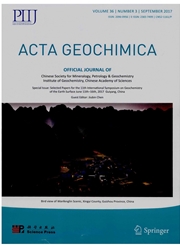

 中文摘要:
中文摘要:
Clastic sediments and sedimentary rocks are widely used for understanding the formation and evolution of the continental crust.The Tietonggou Formation outcrops in the Xiaoqinling region at the southern margin of the North China Craton(NCC)and has unconformable contacts with the underlying Taihua Complex and overlying Paleoproterozoic Xiong’er Group.It mainly consists of quartzite and its protoliths are mature terrigenous clastic rocks.On the basis of the ages of the youngest detrital zircons from the quartzites and the ages of the Xiong’er Group,the depositional ages of the protoliths of the Tietonggou Formation were well constrained to 1.91–1.80 Ga.The U-Pb isotopic data of detrital zircons from the Formation show a major age peak at~2.1 Ga,which is consistent with 2.2–2.0 Ga magmatism in the Trans-North China Orogen of the NCC.Taking into account the texctural and compositional maturity of the Tietonggou Formation quartzite,the~2.1 Ga lithologic units in the Trans-North China Orogen are interpreted as the major source of the Tietonggou Formation.The majority of these~2.1 Ga detrital zircons mostly have highδ18O values(>6.5‰)and negativeεHf(t)values(–7.8–0.0),with corresponding Hf model ages significantly older than their crystallization ages,indicating that these zircons formed from the partial melting of ancient continental crust.The majority of the2.8–2.7 Ga and~2.5 Ga detrital zircons from the Tietonggou Formation had positiveεHf(t)values,and mantle-likeδ18O values,suggesting that the NCC has experienced two stages of significant crustal growth in the Neoarchaean at 2.7 and 2.5 Ga,respectively.The Hf isotopic data of detrital zircons from Paleoproterozoic metasedimentary rocks in the Trans-North China Orogen varied mainly toward the reduction of the radiogenic Hf isotope and gradually show a similar trend of the isotope trajectories of crustal evolution.This reveals that the NCC probably has not developed a long-lived subduction to complete the final assembly of the NCC.Alternatively,the
 英文摘要:
英文摘要:
Clastic sediments and sedimentary rocks are widely used for understanding the formation and evolution of the continental crust. The Tietonggou Formation outcrops in the Xiaoqinling region at the southern margin of the North China Craton (NCC) and has unconformable contacts with the underlying Taihua Complex and overlying Paleoproterozoic Xiong'er Group. It mainly consists of quartzite and its protoliths are mature terrigenous clastic rocks. On the basis of the ages of the youngest detrital zircons from the quartzites and the ages of the Xiong'er Group, the depositional ages of the protoliths of the Tietonggou Formation were well constrained to 1.91-1.80 Ga. The U-Pb isotopic data of detrital zircons from the Formation show a major age peak at ~2.1 Ga, which is consistent with 2.2-2.0 Ga magmatism in the Trans-North China Orogen of the NCC. Taking into account the texctural and compositional maturity of the Tietonggou Formation quartzite, the -2.1 Ga lithologic units in the Trans-North China Orogen are interpreted as the major source of the Tietonggou Formation. The majority of these -2.1 Ga detrital zircons mostly have high fi180 values (〉6.5%0) and negative eHf (t) values (-7.8-0.0), with corresponding Hf model ages significantly older than their crys- tallization ages, indicating that these zircons formed from the partial melting of ancient continental crust. The majority of the 2.8-2.7 Ga and -2.5 Ga detrital zircons from the Tietonggou Formation had positive eHf (t) values, and mantle-like fi180 values, suggesting that the NCC has experienced two stages of significant crustal growth in the Neoarchaean at 2.7 and 2.5 Ga, respec- tively. The Hf isotopic data of detrital zircons from Paleoproterozoic metasedimentary rocks in the Trans-North China Orogen varied mainly toward the reduction of the radiogenic Hf isotope and gradually show a similar trend of the isotope trajectories of crustal evolution. This reveals that the NCC probably has not developed a long-lived subduction to complete
 同期刊论文项目
同期刊论文项目
 同项目期刊论文
同项目期刊论文
 期刊信息
期刊信息
